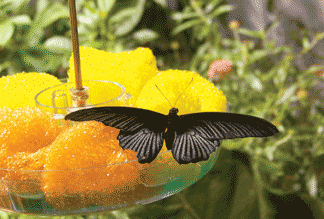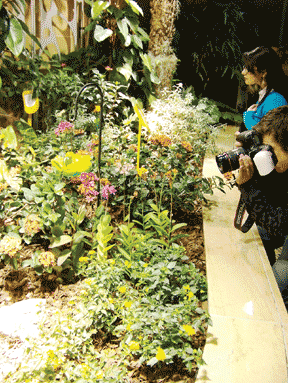Amble through an Eden of Butterflies
Smithsonian’s new butterfly exhibit is well worth the trip
reviewed by Carrie Madren, Bay Weekly Staff Writer
Full of lush foliage, a bright garden teems with butterflies flitting overhead and alighting on nearby flowers. Eden for human and insect, year-round this Washington, D.C., sanctuary stays nearly the same — 80 degrees and 80 percent humidity.
That’s because this garden flourishes inside the Smithsonian Museum of Natural History’s newest permanent exhibit, Butterflies + Plants. The second-floor exhibit features both an exhibition hall and a 1,200-square-foot live butterfly pavilion for you to amble through. The domed, polyester-resin pavilion resembles an oblong igloo. Right angles and corners trap butterflies, so a rounded room helps these fliers stay safe while allowing you a better view.
Inside, more than 400 butterflies — just a few of the 14,500 species in the world — live out their two to four weeks of life fluttering and sipping with their proboscises from grapefruit wedges and Gatorade-soaked sponges.
“People think of museums as having dead things or non-living displays,” said Hans-Dieter Sues, associate director for research and collections at Smithsonian. A living exhibit helps visitors — who may live in the city and not get out into nature often — appreciate diversity.
The exhibit’s more than 30 species hail from D.C. and every continent except Antarctica. So you’ll see butterflies familiar — such as monarchs — and exotic — including morphos, large, iridescent blue beauties. Docents help you identify owl butterflies, zebra long wings, blue glassy tigers, sunset moths, julias, cattle hearts, paper whites and many more. You may even feel their delicate touch, as butterflies occasionally land on visitors.
You’ll see also where butterfly metamorphosis begins: staff pin chrysalises inside a clear Plexiglas box. If you’re lucky, one may wiggle free and emerge as you watch.
“We’ll spend several thousand dollars on butterflies and plants each week,” said Nate Erwin, exhibit manager. That’s because Smithsonian follows U.S. Department of Agriculture rules and doesn’t breed butterflies, for fear of non-native species spawning outside and disturbing native populations. Instead, they rely on chrysalis shipments from butterfly farmers around the globe.
Two years in the making, the butterfly pavilion will cost between $800,000 and $1 million each year to operate. That’s why you pay a $6 admission fee to see the winged fliers in a free museum.
“We hope people come for the butterflies but linger with fascination over the co-evolution that has shaped our environment,” said Ted Schultz, a museum entomologist. Among easy-to-take displays of butterfly facts, read co-evolution stories on colorful, illustrated boards. For instance, discover how fungus-growing ants cultivate their own food source and how butterflies evolved plant-like colorations and shapes as camouflage.
Butterflies helped co-evolve a recent romance, too. On Valentine’s Day, the winged insects inspired a surprise marriage proposal in the pavilion. Who knows what may happen to you.
Butterflies + Plants: daily 10am-5:30pm at the Smithsonian Natural History Museum, 10th & Constitution Ave., Washington, D.C. $6 w/discounts for 15-minute garden stroll: http://butterflies.si.edu.